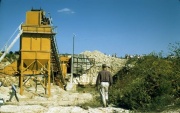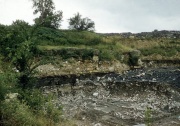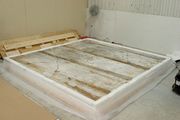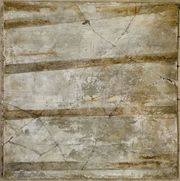Concrete
Description
A hard, strong construction material cured from a semi-fluid matrix of water, Sand, and [[aggregates|aggregate] with Cement and/or Lime. Several types of aggregate are used such as crushed stone, Slag, cinders or gravel. Ancient Romans developed Pozzolan cement about the 3rd century BCE. Modern concretes use various cements such as portland or hydraulic. Concrete is durable and relatively inexpensive. It is used for building foundations, bridges, dams, walls, highways, etc. Concrete is strong in compression but weak in tension so it is often reinforced with steel bars or wire netting. Once a concrete mixture is stirred with water and poured into a mold, it should be allowed to cure slowly over about a week. Stresses, such as vibration, freezing, and rapid drying, will diminish the strength and durability of the concrete. As it ages, concrete is subject to Erosion, spalling, and pollution. Poor mixing can cause erosion. Spalling can be due to freeze-thaw cycles of moisture and ice, salt crystallization, or Corrosion of Steel reinfocements. Acid rain can deplete the natural alkaline reserve of fresh concrete.
Synonyms and Related Terms
béton (Fr.); betão (Port.); Breton
Resources and Citations
- For historical information on cement manufacturing in America, see Saylor Cement Kiln Park near Coplay, Lehigh County, PA
- For deterioration information: E.Sayre, "Deterioration and Restoration of Plaster, Concrete and Mortar" in Preservation and Conservation: Principles and Practice, S.Timmons (ed.), Preservation Press, Washington DC, 1976.
- Van Nostrand's Scientific Encyclopedia, Douglas M. Considine (ed.), Van Nostrand Reinhold, New York, 1976
- Random House, Webster's Encyclopedic Unabridged Dictionary of the English Language, Grammercy Book, New York, 1997
- The American Heritage Dictionary or Encarta, via Microsoft Bookshelf 98, Microsoft Corp., 1998
- Richard S. Lewis, Hawley's Condensed Chemical Dictionary, Van Nostrand Reinhold, New York, 10th ed., 1993
- The Dictionary of Art, Grove's Dictionaries Inc., New York, 1996 Comment: "Concrete"
- Ralph Mayer, A Dictionary of Art Terms and Techniques, Harper and Row Publishers, New York, 1969 (also 1945 printing)
- Dictionary of Building Preservation, Ward Bucher, ed., John Wiley & Sons, Inc., New York City, 1996
- Encyclopedia of Archaeology, Glyn E. Daniel, ed., Thomas Y. Crowell Co., New York, 1977



